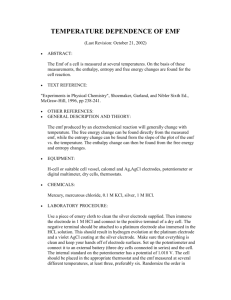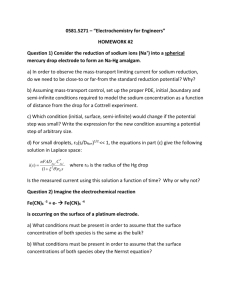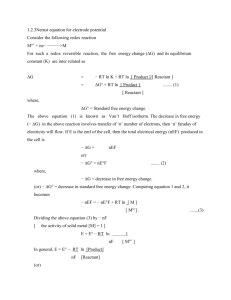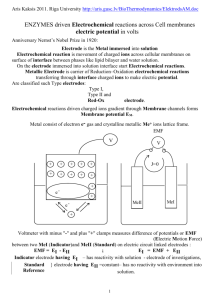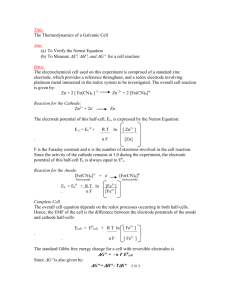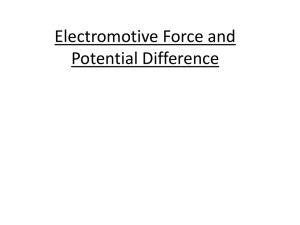Electrochemical Method of Obtaining of Electric Current from
advertisement
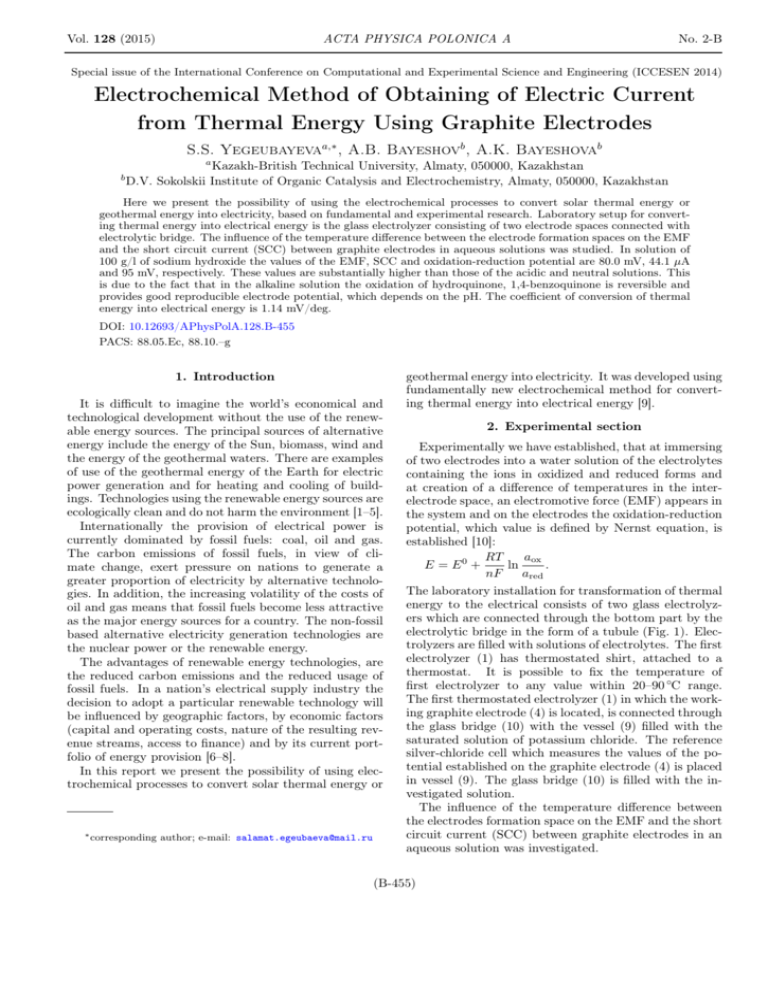
Vol. 128 (2015) ACTA PHYSICA POLONICA A No. 2-B Special issue of the International Conference on Computational and Experimental Science and Engineering (ICCESEN 2014) Electrochemical Method of Obtaining of Electric Current from Thermal Energy Using Graphite Electrodes S.S. Yegeubayevaa,∗ , A.B. Bayeshovb , A.K. Bayeshovab a b Kazakh-British Technical University, Almaty, 050000, Kazakhstan D.V. Sokolskii Institute of Organic Catalysis and Electrochemistry, Almaty, 050000, Kazakhstan Here we present the possibility of using the electrochemical processes to convert solar thermal energy or geothermal energy into electricity, based on fundamental and experimental research. Laboratory setup for converting thermal energy into electrical energy is the glass electrolyzer consisting of two electrode spaces connected with electrolytic bridge. The influence of the temperature difference between the electrode formation spaces on the EMF and the short circuit current (SCC) between graphite electrodes in aqueous solutions was studied. In solution of 100 g/l of sodium hydroxide the values of the EMF, SCC and oxidation-reduction potential are 80.0 mV, 44.1 µA and 95 mV, respectively. These values are substantially higher than those of the acidic and neutral solutions. This is due to the fact that in the alkaline solution the oxidation of hydroquinone, 1,4-benzoquinone is reversible and provides good reproducible electrode potential, which depends on the pH. The coefficient of conversion of thermal energy into electrical energy is 1.14 mV/deg. DOI: 10.12693/APhysPolA.128.B-455 PACS: 88.05.Ec, 88.10.–g 1. Introduction It is difficult to imagine the world’s economical and technological development without the use of the renewable energy sources. The principal sources of alternative energy include the energy of the Sun, biomass, wind and the energy of the geothermal waters. There are examples of use of the geothermal energy of the Earth for electric power generation and for heating and cooling of buildings. Technologies using the renewable energy sources are ecologically clean and do not harm the environment [1–5]. Internationally the provision of electrical power is currently dominated by fossil fuels: coal, oil and gas. The carbon emissions of fossil fuels, in view of climate change, exert pressure on nations to generate a greater proportion of electricity by alternative technologies. In addition, the increasing volatility of the costs of oil and gas means that fossil fuels become less attractive as the major energy sources for a country. The non-fossil based alternative electricity generation technologies are the nuclear power or the renewable energy. The advantages of renewable energy technologies, are the reduced carbon emissions and the reduced usage of fossil fuels. In a nation’s electrical supply industry the decision to adopt a particular renewable technology will be influenced by geographic factors, by economic factors (capital and operating costs, nature of the resulting revenue streams, access to finance) and by its current portfolio of energy provision [6–8]. In this report we present the possibility of using electrochemical processes to convert solar thermal energy or ∗ corresponding author; e-mail: salamat.egeubaeva@mail.ru geothermal energy into electricity. It was developed using fundamentally new electrochemical method for converting thermal energy into electrical energy [9]. 2. Experimental section Experimentally we have established, that at immersing of two electrodes into a water solution of the electrolytes containing the ions in oxidized and reduced forms and at creation of a difference of temperatures in the interelectrode space, an electromotive force (EMF) appears in the system and on the electrodes the oxidation-reduction potential, which value is defined by Nernst equation, is established [10]: aox RT ln E = E0 + . nF ared The laboratory installation for transformation of thermal energy to the electrical consists of two glass electrolyzers which are connected through the bottom part by the electrolytic bridge in the form of a tubule (Fig. 1). Electrolyzers are filled with solutions of electrolytes. The first electrolyzer (1) has thermostated shirt, attached to a thermostat. It is possible to fix the temperature of first electrolyzer to any value within 20–90 ◦C range. The first thermostated electrolyzer (1) in which the working graphite electrode (4) is located, is connected through the glass bridge (10) with the vessel (9) filled with the saturated solution of potassium chloride. The reference silver-chloride cell which measures the values of the potential established on the graphite electrode (4) is placed in vessel (9). The glass bridge (10) is filled with the investigated solution. The influence of the temperature difference between the electrodes formation space on the EMF and the short circuit current (SCC) between graphite electrodes in an aqueous solution was investigated. (B-455) B-456 S.S. Yegeubayeva, A.B. Bayeshov, A.K. Bayeshova Fig. 1. The scheme of setup for research of transformation of thermal energy to electrical: 1 — thermostated electrolyzer; 2 — non-thermostated electrolyzer; 3 — the bridge connecting the electrode spaces, 4 — graphite electrodes; 5 — the voltmeter for measurement of the EMF value; 6 — the ampermeter for measurement of SCC value; 7 — switch; 8 — reference electrode; 9 — vessel with the saturated solution of potassium chloride; 10 — glass bridge filled with the investigated solution; 11 — potentiometer. When the graphite electrodes are immersed into the solution of sodium hydroxide with a concentration of 100 g/l and containing quinine and hydroquinone at concentration higher than 3 g/l, process on the surface of electrodes reaches following equilibrium. potential of graphite electrode increases with temperature and at 70 ◦C, the difference increases to 58.1 mV. As we see from Table II and III, when the temperature is the same in the left and the right spaces of electrolyzer, the EMF between graphite electrodes does not forme. In the sulfuric acid solution with a concentration of 100 g/l and in solution mixture comprising 50 g/l of sulfuric acid and 50 g/l of sodium sulfate, in the presence of oxidation-reduction systems of quinone and hydroquinone (3 g/l), at temperature difference of 70 ◦C, the value of EMF and SCC, reache respectively, 28.0 mV and 13.5 µA, which is relaed with the increase of conductivity of the solution. TABLE II Changes in EMF, SCC and oxidation-reduction potential values, with the increase of the temperature difference in the electrode spaces in sulfuric acid solutions. ∆t, [ ◦C] 0 10 20 30 40 50 60 70 E, [mV] 0 15 38 72 95 125 181 28.0 I, [µA] 0 1.0 21 3.0 42 62 85 135 ∆E, [mV] 0 51 86 125 158 193 256 351 Note: c(C6 H4 O2 )=3 g/l, c(C6 H4 (OH)2 )=3 g/l, c(H2 SO4 )=100 g/l, t0 = 20 ◦C TABLE III The value of potential depends on temperature and is given by the Nernst equation with E 0 = 0.69 V. 3. Results and discussion The ability to participate in quinone reduction reactions was characterized by reduction potential. The quinine reduction ability is usually increased by electron acceptors and decreased by donors [11–13]. Under the influence of mild reduction, the quinines are easily converted into hydroquinone and simplest restored benzoquinones [14]. At increasing the temperature difference in the electrode spaces of the electrolyzer to 70◦ , the EMF between the electrodes and short-circuit current are equal to zero (Table I). The oxidation-reduction TABLE I Changes in EMF values, SCC and oxidation-reduction potential as functions of temperature difference in the electrode spaces. ∆t, [ ◦C] 0 10 20 30 40 50 60 70 E, [mV] 0 0 0 0 0 0 0 0 I, [mA] 0 0 0 0 0 0 0 0 ∆E, [mV] 0 13.6 21.8 30.9 41.3 47.5 54.3 58.1 Note: c(C6 H4 O2 )=3 g/l, c(C6 H4 (OH)2 )=3 g/l, t0 = 20 ◦C Changes in EMF, SCC and oxidation-reduction potential values, with the increase of the temperature difference in the electrode spaces in electrolyte containing sulfuric acid and sodium sulfate. ∆t, [ ◦C] 0 10 20 30 40 50 60 E, [mV] 0 3.0 55 82 121 155 213 I, [µA] 0 13 22 38 55 75 102 ∆E, [mV] 0 5.0 103 153 215 254 335 Note: c(C6 H4 O2 )=3 g/l, c(C6 H4 (OH)2 )=3 g/l, c(H2 SO4 )=50 g/l, c(Na2 SO4 )=50 g/l, t0 = 20 ◦C 70 281 141 373 TABLE IV Changes of EMF, SCC and oxidation-reduction potential, as function of temperature difference in the electrode spaces in sodium sulphate solution. ∆t [ ◦C] 0 10 20 30 40 50 60 70 E, [mV] 0 35 95 21.0 30.0 38.0 473 56.0 I, µA 0 21 62 132 191 251 29.3 31.0 ∆E, [mV] 0 132 259 377 523 655 778 888 Note: c(C6 H4 O2 )=3 g/l, c(C6 H4 (OH)2 )=3 g/l, c(Na2 SO4 )=100 g/l, t0 = 20 ◦C During the experiment, in the solution of sodium sulphate (100 g/l) and a solution containing 50 g/l sodium sulphate and 50 g/l of sodium chloride in the presence of red-ox system C6 H4 O2 -C6 H4 (OH)2 of 3 g/l, the amount of EMF generated between the electrodes and the SCC are significantly increased and constitute 56.0 mV and Electrochemical Method of Obtaining of Electric Current. . . 31.0 µA respectively. These results are presented in Tables IV and V. The maximum change of oxidationreduction potential was 88.8 mV. TABLE V Changes of EMF, SCC and oxidation-reduction potential, as function of the temperature difference in neutral solution. ∆t, [ ◦C] 0 10 20 30 40 50 60 70 E, [mV] 0 71 18.0 263 351 43.0 492 541 I, [µA] 0 25 8.0 141 192 243 282 312 ∆E, [mV] 0 9.0 174 287 412 555 687 79.0 Note: c(C6 H4 O2 )=3 g/l, c(C6 H4 (OH)2 )=3 g/l, c(Na2 SO4 )=50 g/l, c(NaCl)=50 g/l, t0 = 20 ◦C TABLE VI Changies of EMF, SCC and oxidation-reduction potential values, as functions of the temperature difference in the electrode spaces in alkaline solution. ∆t, [ ◦C] 0 10 20 30 40 50 60 70 E, [mV] 0 2. 7.1 15.0 26.2 421 60.0 80.0 I, [µA] 0 1.3 35 9.3 16.0 23.1 323 44.1 ∆E, [mV] 0 9 20 39 52 69 80 95 Note: c(C6 H4 O2 )=3 g/l, c(C6 H4 (OH)2 )=3 g/l, c(NaOH)=100 g/l, t0 = 20 ◦C As can be seen from Table VI, in solution of 100 g/l sodium hydroxide, the values of the EMF, SCC and oxidation-reduction potential constitute 80.0 mV, 44.1 µA and 95 mV, respectively. These are substantially higher than the values in the acidic and neutral solutions. This is due to the fact that the in alkaline solution the oxidation of hydroquinone, 1,4-benzoquinone is reversible and provides good reproducible electrode potential, which depends on the pH. At a constant temperature difference between the electrode spaces of the cell, the values of EMF, and SCC are stabilized within intervals of 33.0–25.0 mV and 0.021– 0.018 mA, respectively, and the redox potential of the electrode during 90 min changes to 19.9 mV as shown in Fig. 2. Fig. 2. Time dependence of EMF (1), SCC (2) and redox potential between the graphite electrodes during of the experiment. B-457 4. Conclusions Thus, while implementing the electrochemical method of converting thermal energy into electrical energy using graphite electrode in aqueous solutions in the presence of a red-ox system of “quinone-hydroquinone”, the maximum value of the electromotive force of 80.0 mV is generated in sodium hydroxide solution, however the value of SCC is 44.1 µA. The coefficient of conversion of thermal energy into electrical energy is 1.14 mV/deg. References [1] S.S. Yegeubayeva, A.B. Bayeshov, A.K. Bayeshova, M.Zh. Zhurınov, Int. J. Chem. Sci. 12, 456 (2014). [2] N.A. Nazarbayev, Global Energy Strategy for Sustainable Development in XXI century, Economy, Moscow 2011. [3] P.P. Bezrukih, YU.D. Arbuzov, G.A. Borisov, V.I. Vissarionov, V.M. Evdokimov, N.K. Malinin, N.V. Ogorodov, V.N. Puzakov, G.I. Sidorenko, A.A. Shpak, The resources and the efficient use of renewable energy sources in Russia, Nauka, St. Petersburg 2002. [4] A. Luke, Power Saver. 4, 57 (2007). [5] G. Doroshin, Review of Environment and Sustainable Development in Kazakhstan, Almaty 2004. [6] M. Nigel, I. Towhidul, Modelling European usage of renewable energy technologies for electricity generation, Technological Forecasting & Social Change, TFS-17979, (2014) p. 13. [7] G. Erdmann, IJMP 3, 143 (2001). [8] A. Satkaliev, Kazakhstan Today 8, 2 (2011). [9] A. Baeshov, S.A. Baeshova, A.K. Baeshova, Thermal energy transformer to the electric, Patent No. 24466 (2011) p. 8. [10] A.L Rothinyan, K.I Tikhonov, I.A Shoshina, Theorethical electrochemistry, Chemistry, Leningrad 1981. [11] D. Kaesong, Organic Reactions, Foreign literature, Moscow 4, 270 (1951). [12] P. Karrer, Course of Organic Chemistry, 2nd ed., Leningrad 1962. [13] L. Fieser, M. Fieser, Organic Chemistry, Advanced Course, Chemistry, Moscow 1996. [14] L.S. Efros, M.V. Gorelik, Chemistry and Technology of intermediates, Chemistry, Leningrad 1980.
